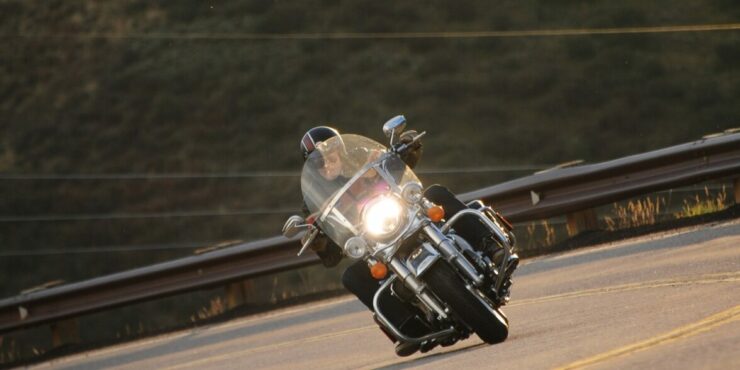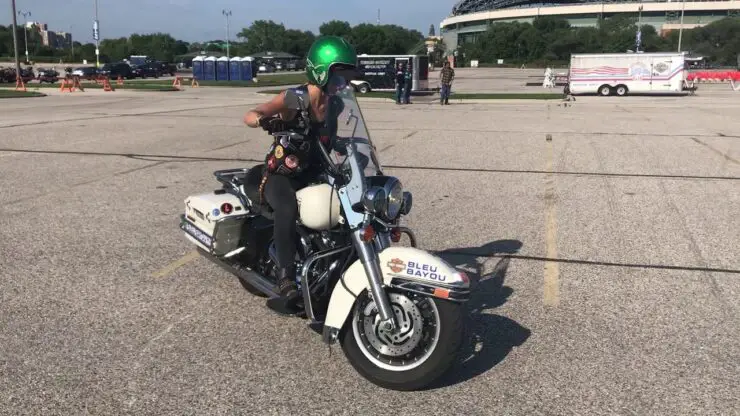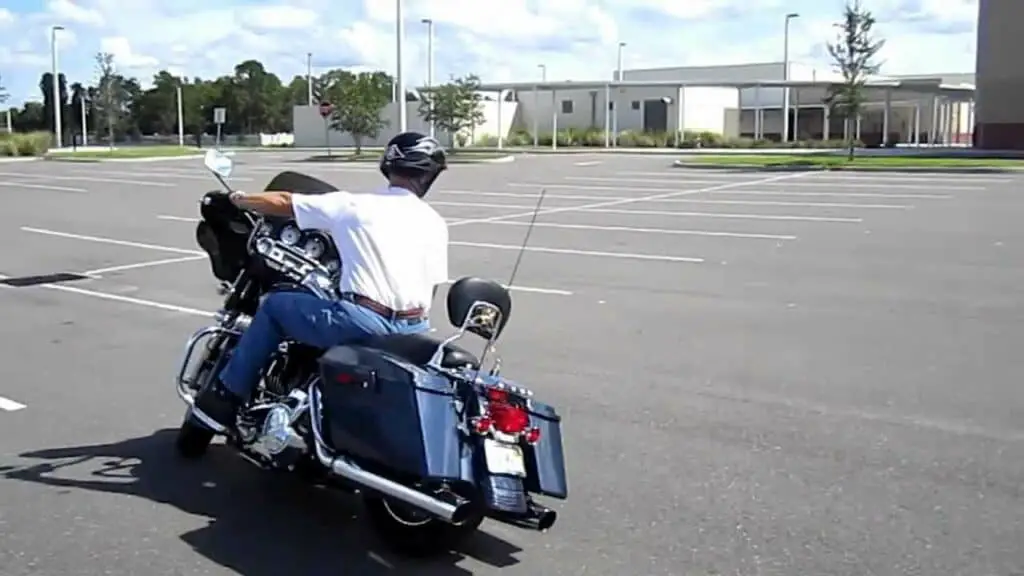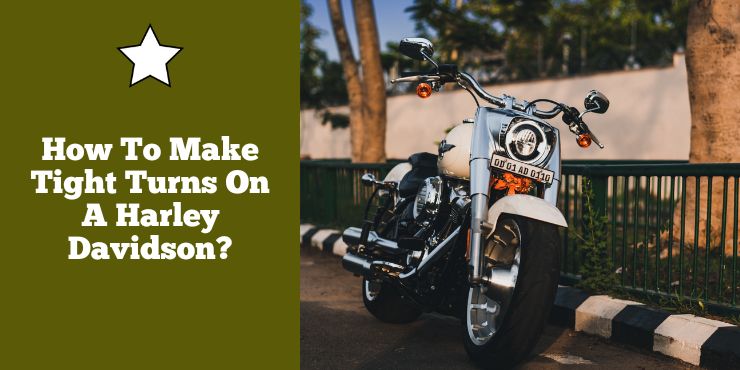Are you ready to master the art of tight turns on a Harley Davidson motorcycle? If the answer is yes, then you’ve come to the right place!
To make tight turns, use counterweighting by leaning your upper body opposite to the bike’s turn direction, keep a steady throttle, and look through the turn. Practice at low speeds to improve control.
In this article, we’ll show you the fundamentals of turning tight on a Harley Davidson and provide helpful tips to ensure your success. So if you’re ready to experience the freedom of the open road, buckle up and let’s get started!
Preparation for mastering tight turns
Taking tight turns on a Harley-Davidson bike can be an enjoyable and exhilarating experience. However, it requires skill, focus, and proper preparation to ensure a safe and enjoyable ride. By carrying out the right preparation, you will give yourself a better platform to master the art of taking tight turns on your Harley-Davidson bike. These steps will help you enhance your riding abilities and have a smoother and more controlled experience on the road. Here are some of the ways through which you can prepare yourself to learn how to take tight turns.
Use the right safety gear
It is important to keep in mind that safety should be prioritized when learning to make tight turns on your bike. Safety gear will be a fundamental aspect of motorcycle riding and it will become even more critical when taking turns. Make sure that you have the necessary safety gear such as –
- Always wear a properly fitted, DOT-approved helmet for protecting your head in the event of an accident
- You must invest in a study jacket, gloves, pants, and boots designed for motorcycle riding as they’ll provide protection from abrasions and minimize injuries
- Wear shatterproof goggles or a full-face helmet with a face shield to shield your eyes from debris and enhance visibility
- Incorporate reflective elements on your clothing or accessories for improving visibility, especially during nighttime rides
Inspect your motorcycle
Before you hit the road, you need to conduct a thorough inspection of your Harley-Davidson bike. You must pay close attention to areas like –
- Check tire pressure and tread depth as worn-out or improperly inflated tires could affect your motorcycle’s handling and grip during turns
- Make sure that the brakes are in proper working condition
- Both the front and rear brakes must respond smoothly and offer sufficient stopping power
- Confirm that all the lights and turn signals are functioning properly as it’ll ensure that other vehicles can see your intentions during turns
- Check the levels of oil, coolant, and brake fluid as insufficient levels can result in mechanical issues and compromise your motorcycle’s performance
Practice in a safe space
Before you tackle challenging turns on the road, you must practice in a controlled and safe environment. You should look for a parking lot or open space where you possibly can. Here is how you can prepare yourself to practice in a safe space –
- Get comfortable with the weight and balance of your Harley-Davidson bike
- Practice slow-speed maneuvers like figure eights and U-turns to develop a sense of control
- Learn to shift your body weight and position yourself correctly when you’re entering or exiting turns as it’ll help you maintain stability and control throughout the turn
- Begin with slower speeds and gentle leans before gradually increasing both as you gain confidence and proficiency
Prepare the bike for the turn
You do not just have to prepare yourself to learn to take turns but your bike should also be prepared. If you’ve got a Harley in prime condition, it will help you be in a better position to learn to make turns. You must take certain steps to prepare your Harley-Davidson bike to learn to take turns.
For starters, your Harley-Davidson motorcycle needs to have ample gas such that it doesn’t stop mid-way through the session. Moreover, the tires need to have ample air so that you can ride your bike smoothly. Your bike must be properly warmed up so that the engine oil gets distributed to all the right places and your bike is prepared to be driven.
Remember to keep your eyes focused on the intended path through the turn instead of fixating on the immediate road in front of you. This will help you maintain a smooth line and anticipate any potential hazards.

Different types of turns on your Harley-Davidson motorcycle
Harley-Davidson bikes are built for the open road and understanding how to navigate different types of turns will be important for a smooth and controlled riding experience. Regardless of the type of turn you are learning, each one will require a specific set of skills and techniques. But before coming to that, you will first need to know the different types of turns that you can take on your bike. Here are the different types of turns that will help you confidently maneuver your Harley-Davidson bike through any curve.
#1. Slow-speed turns
Slow-speed turns usually occur in parking lots, tight corners, or congested areas. These turns typically require precise control and balance to navigate safely. To carry out this type of turn, you will need to follow a specific set of steps –
For starters, you need to keep your eyes focused on where you wish to go, looking through the turn rather than down at the ground. This will help you maintain a smooth line and ensure proper positioning. Shift your body weight slightly towards the inside of the turn and counterbalance your motorcycle’s lean by pushing on the handlebar on the opposite side. This technique will help maintain stability.
You should be feathering the clutch by engaging and disengaging it as it can offer better throttle control, especially in low-speed situations. This will allow for smoother acceleration and deceleration. Moreover, gentle and consistent throttle control will help you maintain a steady speed throughout the turn. You must avoid sudden bursts of acceleration or deceleration, which could disrupt stability.
#2. Medium-speed turns
Medium-speed turns usually occur on open roads or city streets with wider curves. These turns will require a balance between control and maintaining an appropriate speed. To do that, you should consider the technique of choosing the suitable line, positioning the body, and maintaining consistent throttle control.
You must choose a suitable line through the curve, generally following the natural arc of the road. You must stay in the middle of the lane or slightly towards the inside, maintaining a comfortable margin from the centerline or road edge.
Position your body upright and centered on the bike. Lean your motorcycle into the turn while keeping your upper body and head aligned with the horizon. This will allow for better control and balance. You should maintain consistent and smooth throttle control as you are entering and exiting the turn. Gradually apply throttle when entering the turn and progressively roll it on as you exit to maintain stability and traction.
#3. High-speed turns
High-speed turns typically occur on open highways or sweeping curves where higher speeds are possible. These turns will require advanced riding skills and increased awareness. The technique for this is slightly different but along the same lines.
Start your turn slightly earlier than you would if you were taking a medium-speed turn. This will allow for a wider arc and a smoother transition through the curve. You must shift your body weight towards the inside of the turn and lean with the bike. Maintain a relaxed upper body while keeping your eyes focused on the exit of the turn.
If needed, you should apply the brakes smoothly and progressively before you enter the turn to reduce speed. You should avoid harsh braking as it could upset the balance of the motorcycle. Look to maintain a consistent line throughout the turn, avoiding any sudden corrections or excessive changes in trajectory. This will provide stability and minimize the risk of traction loss.
#4. U-turns
U-turns are needed when you have to change the direction completely. Such turns often require tight turns and precise control. This is why you need to follow a complex technique to learn a U-turn.
Before you initiate the U-turn, you should identify the exit point and visually track it. This will help you maintain a smooth line and ensure proper positioning. Start your U-turn with a slightly wider entry, allowing for more room to maneuver. Make use of the clutch and throttle control to maintain a steady and controlled speed.
Turn your head and look in the direction that you want to go. Keep your body upright and centered on the bike, maintaining a balanced position. Feathering the clutch will provide better control and smoother acceleration during U-turns. Modulating the clutch will help you maintain balance and prevent stalling.

How to make tight turns on a Harley-Davidson motorcycle
Making tight turns on a Harley-Davidson motorcycle requires skill, control, and proper technique. Whether you have to navigate a sharp corner or maneuver through crowded city streets, mastering these techniques will help you enhance your ability to make tight turns with confidence and precision. Once you know the right technique to make tight turns, it will take your job a whole lot easier. Here is how to make tight turns on a Harley-Davidson motorcycle and ride with ease and confidence.
#1. Look ahead and plan
Before you enter a tight turn, it will be important to look ahead and plan your approach. This will allow you to anticipate any potential obstacles or hazards and choose the best line through the turn. You need to keep your eyes focused on where you wish to go rather than fixating on the ground or distractions around you. You should be visualizing the ideal path through the turn and mentally prepare yourself for the maneuver.
#2. Lean into the turn
Leaning into the turn will be an important technique for maintaining balance and control during tight turns. With your eyes focused, it will allow your body and bike to follow your line of sight. Then, you should shift your body weight toward the inside of the turn. Lean your upper body slightly in the direction of the turn while keeping your eyes and head level. This will counteract the centrifugal force and help maintain stability.
You must bend your arms slightly at the elbows and keep your knees in contact with the fuel tank. This will allow for greater control and responsiveness. Initiate the lean by gently applying pressure on the handlebars in the direction of the turn. Lean your bike smoothly and progressively while maintaining a relaxed grip.
#3. Counterweight the turn
Counterweighing is a technique that helps in balancing the motorcycle when making tight turns. This involves shifting your body weight in the opposite direction of the turn. To counterweight the turn, you must maintain the focus on the desired path through the turn. As you’re entering the turn, you should shift your body weight toward the outside of the turn, away from the direction you are turning. This will help balance the motorcycle and prevent excessive leaning.
Make use of your legs to apply pressure against the seat or footpegs on the side opposite to the turn. This will counteract the centrifugal force and maintain stability.
#4. Use the front brake to initiate the turn
Utilizing the front brake for initiating the turn will help you control speed and maintain stability. For this step, you will need to maintain a controlled speed as you are approaching the turn. Reduce your speed if necessary to ensure safety and maneuverability. You must keep your eyes focused on where you wish to go, allowing your body and bike to follow your line of sight.
Before you enter the turn, lightly apply pressure to the front brake for transferring weight to the front wheel. This will help compress the suspension and improve traction for better control. As you start the turn, you should gradually release the front brake to allow the suspension to rebound. This will allow for smoother steering and maintain balance.
#5. Power through the turn
Applying controlled power through the turn will help enhance stability and control, giving you a smoother turn. While keeping your focus on the intended path through the turn, you need to maintain consistent and smooth throttle control through the turn. Modulate the throttle to match the speed and lean angle needed for the turn.
If necessary, you should gradually increase throttle input during the turn to power through and maintain momentum. You should avoid any sudden bursts of acceleration as they can upset the balance of your bike. As you are exiting the turn, you should gradually release the throttle to maintain control and stability.
How to troubleshoot common issues while taking turns on your Harley-Davidson bike
While Harley-Davidson motorcycles are renowned for their power, performance, and reliability, occasional issues could arise when you’re taking tight turns. These issues could greatly affect your riding experience and prevent you from turning properly. Understanding how to troubleshoot common problems will be essential for maintaining optimal performance and ensuring you can safely turn on the road. Before you can troubleshoot issues on your Harley-Davidson bike, you will first need to identify the issue. By identifying the causes and implementing appropriate solutions, you’ll be able to address these issues and enjoy a smoother and more enjoyable ride.
#1. Low-speed lean issues
Sometimes, you might experience difficulty in making tight turns or maintaining balance at low speeds. Some of the common causes of low-speed lean issues include insufficient leaning, improper throttle control, and inadequate clutch control. There are workarounds to these issues to help you troubleshoot the problem.
If there is insufficient leaning, you should make sure that you are leaning appropriately into the turn, shifting your body weight towards the inside. You should practice proper body positioning techniques, such as bending your arms, using your knees, and looking ahead.
In the case of improper throttle control, make use of smooth and controlled throttle inputs when maneuvering at low speeds. Abrupt or excessive throttle applications can unsettle the bike’s balance. You should gradually roll on and off the throttle for maintaining stability.
Proper clutch control will be important when maneuvering at low speeds. Feathering the clutch can offer better control and help maintain balance during slow turns. You should practice modulating the clutch and find the right engagement point for smoother acceleration and deceleration.

#2. High-speed stability
Sometimes, you might be experiencing instability or wobbling at higher speeds. There are numerous causes for it including tire issues, suspension setup, wheel alignment, and more.
If there are tire issues, you must check the tire pressure and make sure they are properly inflated. Underinflated or overinflated tires can affect stability. Moreover, inspect the tires for any signs of wear or damage. It would be best if you replaced worn-out tires as necessary.
If there are suspension setup issues, you should remember suspension settings can greatly affect high-speed stability. You need to consider adjusting the suspension for matching your weight and riding style. Consult the owner’s manual or seek professional help for proper suspension tuning.
If you’re having wheel alignment issues, you should make sure that the front and rear wheels are properly aligned. Misaligned wheels will result in instability. If needed, you shouldn’t hesitate in consulting a professional for wheel alignment and adjustment.
#3. Counterweighing too much
When you’re overcompensating with excessive counterweighing during turns, it can result in issues. This can be caused by a lack of confidence and not focusing on the turn enough.
Excessive counterweighing can be a result of a lack of confidence in leaning into the turn. Practice proper body positioning techniques, including leaning into the turn and shifting the body weight accordingly. You need to gradually build your confidence and practice in a controlled environment.
You must focus on the turn by keeping your eyes focused on where you want to go instead of being fixated on the ground. The proper visual focus will help you maintain balance and reduce the tendency to counterweight excessively.
#4. Front brake wobble
Sometimes, you might experience wobbling or vibrations when applying the front brake. Some of the causes for this might be warped brake discs, improper brake pad wear, and loose or worn steering components.
A warped brake disc could cause a front brake wobble. You must inspect the brake disc for any signs of warping, such as uneven wear or visible damage. If needed, you should have the disc brake replaced or resurfaced by a qualified technician.
Check the brake pads for uneven wear or contamination. Worn-out or contaminated brake pads could cause uneven braking force and contribute to front brake wobble. You must replace the brake pads if needed and ensure proper alignment.
Moreover, you need to inspect the steering components like the handlebar, front forks, and triple tree, for any signs of looseness or wear. Loose or worn components could result in instability and front brake wobble. Tighten or replace components as necessary.
Also read: Harley-Davidson 48 vs Iron 1200
FAQs
What should I consider when making tight turns on a Harley Davidson?
When making tight turns on a Harley Davidson, it’s important to consider the position of your feet and body, the speed of the bike, the width and type of the turn, and the condition of the road. When positioning your feet and body, make sure your feet are firmly planted on the foot pegs and your body is positioned slightly forward and to the inside of the turn. Your speed should be adjusted accordingly for the type of turn and road surface, and you should adjust your steering and throttle as needed to ensure a smooth ride.
What techniques should I use to make tight turns on a Harley Davidson?
When making tight turns on a Harley Davidson, it is important to use the correct techniques to ensure a smooth ride. When entering the turn, the rider should lean their body into the turn and reduce their speed while gradually increasing their throttle and steering. When exiting the turn, the rider should gradually reduce their throttle and increase their speed while straightening their body and leaning out of the turn.
How can I practice making tight turns on a Harley Davidson?
The best way to practice making tight turns on a Harley Davidson is to start by practicing in an open space away from other vehicles

